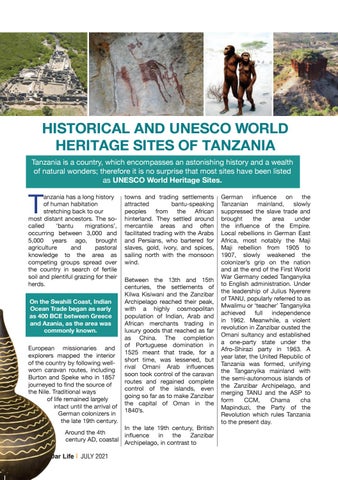HISTORICAL AND UNESCO WORLD HERITAGE SITES OF TANZANIA Tanzania is a country, which encompasses an astonishing history and a wealth of natural wonders; therefore it is no surprise that most sites have been listed as UNESCO World Heritage Sites.
T
anzania has a long history of human habitation stretching back to our most distant ancestors. The socalled ‘bantu migrations’, occurring between 3,000 and 5,000 years ago, brought agriculture and pastoral knowledge to the area as competing groups spread over the country in search of fertile soil and plentiful grazing for their herds. On the Swahili Coast, Indian Ocean Trade began as early as 400 BCE between Greece and Azania, as the area was commonly known. European missionaries and explorers mapped the interior of the country by following wellworn caravan routes, including Burton and Speke who in 1857 journeyed to find the source of the Nile. Traditional ways of life remained largely intact until the arrival of German colonizers in the late 19th century.
towns and trading settlements attracted bantu-speaking peoples from the African hinterland. They settled around mercantile areas and often facilitated trading with the Arabs and Persians, who bartered for slaves, gold, ivory, and spices, sailing north with the monsoon wind. Between the 13th and 15th centuries, the settlements of Kilwa Kisiwani and the Zanzibar Archipelago reached their peak, with a highly cosmopolitan population of Indian, Arab and African merchants trading in luxury goods that reached as far as China. The completion of Portuguese domination in 1525 meant that trade, for a short time, was lessened, but rival Omani Arab influences soon took control of the caravan routes and regained complete control of the islands, even going so far as to make Zanzibar the capital of Oman in the 1840’s.
In the late 19th century, British Around the 4th influence in the Zanzibar century AD, coastal Archipelago, in contrast to
62
Dar Life I JULY 2021
German influence on the Tanzanian mainland, slowly suppressed the slave trade and brought the area under the influence of the Empire. Local rebellions in German East Africa, most notably the Maji Maji rebellion from 1905 to 1907, slowly weakened the colonizer’s grip on the nation and at the end of the First World War Germany ceded Tanganyika to English administration. Under the leadership of Julius Nyerere of TANU, popularly referred to as Mwalimu or ‘teacher’ Tanganyika achieved full independence in 1962. Meanwhile, a violent revolution in Zanzibar ousted the Omani sultancy and established a one-party state under the Afro-Shirazi party in 1963. A year later, the United Republic of Tanzania was formed, unifying the Tanganyika mainland with the semi-autonomous islands of the Zanzibar Archipelago, and merging TANU and the ASP to form CCM, Chama cha Mapinduzi, the Party of the Revolution which rules Tanzania to the present day.



















